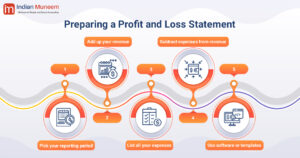You check your bank account at the end of the month, and the numbers seem okay. Bills are paid, staff got their salaries, and maybe there’s even a little left over. But is your business actually making money?
That’s the kind of question a bank statement can’t answer, but a profit and loss statement can.
No matter the size and place of your business, one financial report that truly tells you how your business is performing is the profit and loss statement. And here’s the thing: if you’re not using one regularly, you’re driving blind.
So, let’s unpack this.
Profit and Loss Statement Meaning
At its core, a profit and loss statement (often called a P&L Statement) shows how much money your business made (or lost) over a period of time—usually monthly, quarterly, or annually. It tells you:
- Total income (or revenue)
- Total expenses (like rent, salaries, materials, utilities, etc.)
- Net profit or net loss (what’s left over after all expenses)
It’s like a scoreboard. You see the money coming in, the money going out, and whether you’re actually ahead or behind.
People also call it a business profit and loss statement, profit loss statement, or just profit and loss. Different name, same job—it’s the financial heartbeat of your business.
Here’s a very basic example:
| Item | Amount |
|---|---|
| Revenue (Sales) | $100,000 |
| Expenses | $75,000 |
| Net Profit | $25,000 |
Also read: Common Accounting Errors: How to Detect and Avoid Them
Importance of the Profit and Loss Statement
Let’s go beyond the obvious (yes, it tells you your profit). The real power of the profit and loss statement lies in its ability to guide decisions and spot problems early.
1. It helps you price right: Are your prices too low? If your revenue is growing but your profits aren’t, your pricing might need work. A P&L Statement highlights these disconnects.
2. It flags overspending: Some costs creep up quietly—subscriptions, supplies, freelance work. Comparing your profit and loss over months or years helps you catch and cut the waste.
3. It makes tax time easier: Nobody enjoys tax season. But if your books are clean and your profit loss statement is up-to-date, tax filing becomes much smoother—and more accurate.
4. It proves your business is healthy: Need a loan? Looking for investors? Applying for grants? You’ll need a business profit and loss statement to show your credibility and profitability.
5. It helps you make smart decisions: Do you need to hire someone? Can you afford that new tractor or software? Should you expand into a new region? The profit and loss statement helps answer all these questions without guessing.
6. It keeps you proactive, not reactive: Running a business involves surprises. But your P&L Statement helps you anticipate cash flow challenges, seasonal slumps, or rising expenses before they become real problems.
Types of P&L Statement
When we talk about types of profit and loss statements, it boils down to two methods: the cash basis and the accrual basis. Both approaches produce a profit and loss statement, but the timing of the entries is what changes everything.
| Feature | Cash Basis | Accrual Basis |
|---|---|---|
| When Income Is Recorded | When cash is received | When income is earned (even if unpaid) |
| When Expenses Are Recorded | When cash is paid | When expenses are incurred (even if unpaid) |
| Reflects Cash Flow Accurately | ✅ Yes | ❌ Not directly (need a cash flow statement) |
| Reflects Profit Accurately | ❌ Can be misleading | ✅ More accurate over time |
| Complexity Level | Simple to manage | More complex, needs tracking receivables/payables |
| Used By | Small businesses, sole traders | Larger businesses, firms, and required by IFRS/GAAP |
| Compliance Requirement | Often accepted for tax in small businesses | Required for financial reporting & audits |
How to Prepare a Profit and Loss Statement
Let’s make this real. Here’s a step-by-step to get your P&L statement for small business ready, even if you’re not an accountant.

Step 1: Pick your reporting period
Most businesses prepare a P&L Statement monthly, quarterly, or annually. Some even do weekly reports for high-volume operations.
Stick with something manageable but regular. If you wait till year-end, it’s too late to fix problems.
Step 2: Add up your revenue
This includes all the income earned from your primary business operations.
- Sales
- Service income
- Rentals
- Any other regular income streams
Make sure it’s actual earned revenue—not just invoices you’ve sent.
Step 3: List all your expenses
Include everything it costs to run your business during that period:
- Wages and salaries
- Rent and utilities
- Software subscriptions
- Materials and supplies
- Advertising and marketing
- Professional services (like your accountant or bookkeeper)
- Loan interest
- Repairs and maintenance
- Travel expenses
- Depreciation (if applicable)
Pro tip: Categorize these. It helps with analysis later.
Step 4: Subtract expenses from revenue
Revenue – Expenses = Net Profit (or Loss)
If it’s positive, great. If it’s negative, you’re running at a loss—and it’s time to reassess.
Step 5: Use software or templates
You can do this in Excel, but accounting software like Xero, QuickBooks, or MYOB automates most of it. These platforms often come with profit loss statement templates built in.
And if you’re drowning in admin and can’t find time to get this done, this is where teams like Indian Muneem can step in.
We specialize in supporting businesses and accounting firms across NZ, AUS, SG, the US, UK, and Canada with outsourced financial reporting service that’s fast, accurate, and fully personalized to your industry. Whether you’re a CA firm or an agri-based business, our experts can handle your reporting while you focus on growing your business.
Conclusion
A profit and loss statement is not just a piece of paper or a spreadsheet. It’s your business story in numbers.
Whether you’re making cheese in Wellington, running an e-commerce store in London, or doing tax prep in Toronto, this document shows whether all your hard work is paying off—or bleeding money.
Here’s the takeaway:
- It’s not about how much you earn—it’s about how much you keep.
- A clean business profit and loss statement helps you run smarter, not just harder.
- Use it monthly. Not just for taxes. But to make real-time, informed decisions.
And if you’re tired of chasing receipts, misplacing invoices, or running reports last-minute, there are pros who can take that off your plate. Because as your business grows, so should the way you track your success.
Now’s the time to stop guessing and start measuring what really matters.




